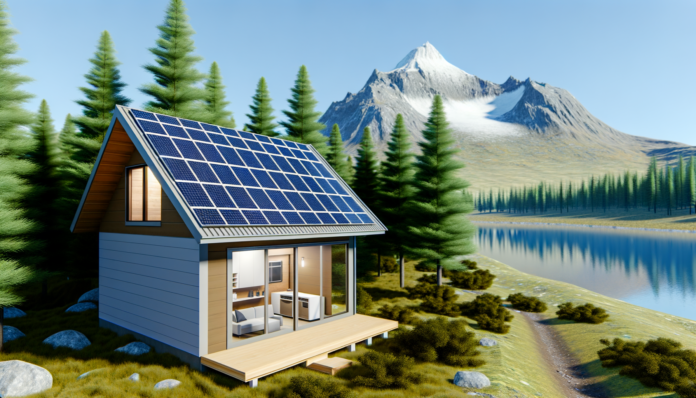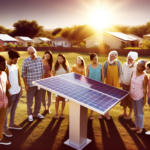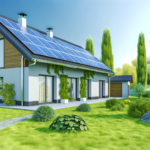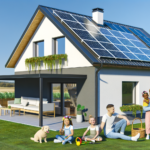Introduction to Off-Grid Solar Living
What is Off-Grid Solar Living?
Off-grid solar living refers to a lifestyle where individuals or communities generate their own electricity using solar power, completely independent of the traditional utility grid. This self-sufficient approach involves harnessing energy from the sun through solar panels, storing it in batteries, and converting it for use in homes, farms, or other facilities. The goal is to achieve energy independence, reduce reliance on fossil fuels, and promote a sustainable way of living.
Benefits of Going Off-Grid
Choosing to live off-grid with solar power offers numerous advantages:
- Energy Independence: By generating your own electricity, you are no longer subject to power outages or fluctuations in utility prices.
- Environmental Impact: Solar power is a clean, renewable energy source that significantly reduces your carbon footprint compared to traditional fossil fuels.
- Cost Savings: While the initial investment can be substantial, over time, you can save money on energy bills and potentially benefit from government incentives or rebates.
- Remote Accessibility: Off-grid solar systems are ideal for remote locations where connecting to the utility grid is impractical or too expensive.
- Resilience: Off-grid systems can be designed to withstand diverse weather conditions, ensuring a reliable energy supply even during natural disasters.
Who is This Guide For?
This guide is designed for a diverse audience, including:
- Outdoor Enthusiasts: Individuals who enjoy spending time in nature and want to power their cabins, RVs, or campsites sustainably.
- Remote Dwellers: People living in isolated areas where connecting to the utility grid is not feasible.
- Eco-Conscious Homeowners: Those looking to reduce their environmental impact and embrace a greener lifestyle.
- Cost-Conscious Individuals: Homeowners seeking to lower their energy bills and gain financial independence from utility companies.
- DIY Enthusiasts: Individuals interested in hands-on projects and learning about renewable energy technologies.
Whether you are motivated by environmental concerns, financial savings, or the desire for energy independence, this guide will provide you with the knowledge and tools needed to thrive in off-grid solar living.
Understanding Solar Power Basics
How Solar Panels Work
Solar panels, also known as photovoltaic (PV) panels, convert sunlight into electricity. This process begins when sunlight hits the solar cells within the panel. These cells are typically made from silicon, a semiconductor material. When sunlight strikes the silicon, it excites electrons, creating an electric current. This phenomenon is known as the photovoltaic effect.
The generated direct current (DC) electricity is then captured by the wiring in the solar panel and directed to an inverter, which converts it into alternating current (AC) electricity. AC is the standard form of electricity used in homes and businesses. The efficiency of this conversion process depends on the quality of the solar cells and the amount of sunlight the panels receive.
Key Components of a Solar Power System
An off-grid solar power system comprises several essential components, each playing a crucial role in generating, storing, and utilizing solar energy:
- Solar Panels: These are the primary devices that capture sunlight and convert it into electricity.
- Inverter: Converts the DC electricity produced by the solar panels into AC electricity, which is used by most household appliances.
- Batteries: Store excess electricity generated during sunny periods for use during cloudy days or at night.
- Charge Controller: Regulates the voltage and current coming from the solar panels to prevent overcharging the batteries.
- Mounting System: Secures the solar panels to the roof or ground, ensuring they are positioned to capture maximum sunlight.
- Wiring and Electrical Components: Connect all parts of the system, allowing electricity to flow from the panels to the inverter, batteries, and household appliances.
Types of Solar Power Systems
There are several types of solar power systems, each designed to meet different energy needs and preferences:
- Grid-Tied Systems: These systems are connected to the public electricity grid. They allow homeowners to use solar power when available and draw from the grid when solar energy is insufficient. Excess energy can be fed back into the grid, often earning credits or payments from the utility company.
- Off-Grid Systems: Completely independent of the public electricity grid, these systems rely solely on solar panels and battery storage to meet all energy needs. They are ideal for remote locations where grid access is unavailable or for those seeking complete energy independence.
- Hybrid Systems: Combining elements of both grid-tied and off-grid systems, hybrid systems are connected to the grid but also include battery storage. This setup provides the flexibility to use solar power, store excess energy, and draw from the grid when necessary, offering a reliable and resilient energy solution.
Understanding these basics is crucial for anyone considering off-grid solar living. By grasping how solar panels work, recognizing the key components of a solar power system, and knowing the different types of systems available, you can make informed decisions that best suit your energy needs and lifestyle.
Planning Your Off-Grid Solar System
Assessing Your Energy Needs
Before diving into the world of off-grid solar living, it’s crucial to understand your energy requirements. Start by conducting a detailed energy audit of your household. List all the electrical appliances you plan to use, noting their wattage and the number of hours they will be in operation each day. This will help you calculate your daily energy consumption in watt-hours (Wh).
For example:
- LED Light Bulb: 10W x 5 hours = 50Wh
- Refrigerator: 150W x 24 hours = 3600Wh
- Laptop: 50W x 8 hours = 400Wh
Sum these values to get your total daily energy consumption. This figure will be the foundation for designing your off-grid solar system, ensuring it meets your needs without overloading or underperforming.
Choosing the Right Solar Panels
Selecting the appropriate solar panels is a critical step in your off-grid journey. Solar panels come in various types, including monocrystalline, polycrystalline, and thin-film. Each type has its own efficiency rates and cost implications.
- Monocrystalline Panels: Known for their high efficiency and longevity, these panels are ideal for limited space but come at a higher cost.
- Polycrystalline Panels: Slightly less efficient but more affordable, making them a popular choice for larger installations.
- Thin-Film Panels: Flexible and lightweight, these panels are less efficient and typically used for specialized applications.
Consider the amount of sunlight your location receives, known as peak sun hours, to determine the number of panels you’ll need. For instance, if your daily energy requirement is 5000Wh and your location receives 5 peak sun hours per day, you’ll need a system that can generate 1000W per hour (5000Wh / 5 hours = 1000W).
Selecting Batteries and Storage Solutions
Energy storage is essential for off-grid living, as it ensures a continuous power supply even when the sun isn’t shining. Batteries store the excess energy generated during the day for use at night or during cloudy periods. The two main types of batteries used in solar systems are lead-acid and lithium-ion.
- Lead-Acid Batteries: These are more affordable but have a shorter lifespan and lower depth of discharge (DoD), meaning they can’t be drained as deeply without reducing their lifespan.
- Lithium-Ion Batteries: More expensive but offer a longer lifespan, higher efficiency, and greater DoD, making them a better long-term investment.
To determine the battery capacity you need, calculate your total daily energy consumption and multiply it by the number of days you want to store energy for. For example, if your daily consumption is 5000Wh and you want 2 days of storage, you’ll need a battery bank with a capacity of 10,000Wh (5000Wh x 2 days).
Inverters and Charge Controllers
Inverters and charge controllers are vital components of your off-grid solar system. The inverter converts the direct current (DC) produced by your solar panels into alternating current (AC), which is used by most household appliances. Charge controllers regulate the voltage and current coming from the solar panels to the batteries, preventing overcharging and extending battery life.
- Inverters: Choose an inverter that matches your system’s voltage and can handle the total wattage of your appliances. Pure sine wave inverters are recommended for sensitive electronics, while modified sine wave inverters are more affordable but less efficient.
- Charge Controllers: There are two main types: Pulse Width Modulation (PWM) and Maximum Power Point Tracking (MPPT). MPPT controllers are more efficient and can extract more power from your solar panels, especially in varying weather conditions.
By carefully assessing your energy needs, selecting the right solar panels, batteries, inverters, and charge controllers, you can design a robust and efficient off-grid solar system tailored to your lifestyle. This planning phase is crucial for ensuring a smooth transition to off-grid living and maximizing the benefits of your solar investment.
Installation and Setup
Site Selection and Preparation
Choosing the right site for your solar panels is crucial for maximizing their efficiency. **Location** is key; you need a spot that receives ample sunlight throughout the day, free from obstructions like trees, buildings, or other structures that could cast shadows. Ideally, the site should have a clear southern exposure if you’re in the northern hemisphere, or northern exposure if you’re in the southern hemisphere.
**Preparation** involves clearing the area of any debris and ensuring the surface is stable and level. If you’re installing panels on a roof, make sure it is structurally sound and can support the weight of the panels. Ground-mounted systems require a solid foundation, often involving concrete footings or metal frames anchored into the ground.
Mounting Solar Panels
Once the site is prepared, the next step is to mount the solar panels. There are several mounting options available, including:
– **Roof Mounts**: These are ideal for residential installations. They keep the panels out of the way and utilize existing space efficiently.
– **Ground Mounts**: Suitable for larger installations or when roof space is limited. They offer flexibility in positioning and can be adjusted for optimal sun exposure.
– **Pole Mounts**: These elevate the panels off the ground and can be manually adjusted to track the sun.
**Installation Steps**:
1. **Install Mounting Hardware**: Secure the mounting brackets to the roof or ground. Ensure they are aligned and spaced according to the panel specifications.
2. **Attach Rails**: Fix the rails to the mounting brackets. These rails will hold the solar panels.
3. **Mount Panels**: Place the solar panels onto the rails and secure them with clamps or bolts. Ensure they are tightly fastened to withstand wind and weather conditions.
Connecting Components
With the panels mounted, the next step is to connect all the components of your solar power system. This includes wiring the panels to the inverter, charge controller, and battery storage.
1. **Wiring Panels**: Connect the solar panels in series or parallel, depending on your system design. Series connections increase voltage, while parallel connections increase current.
2. **Inverter Connection**: The inverter converts the DC power generated by the panels into AC power for household use. Connect the panels to the inverter following the manufacturer’s instructions.
3. **Charge Controller**: This device regulates the voltage and current coming from the solar panels to the batteries. Connect the charge controller between the panels and the battery bank.
4. **Battery Bank**: Connect the batteries to the charge controller. Ensure the batteries are properly wired in series or parallel to match the system’s voltage requirements.
Safety Considerations
Safety is paramount when installing and setting up your off-grid solar system. Here are some key considerations:
– **Electrical Safety**: Always turn off the power before making any connections. Use insulated tools and wear rubber-soled shoes to prevent electrical shocks.
– **Structural Safety**: Ensure all mounting hardware is securely fastened and can withstand local weather conditions, including wind and snow loads.
– **Fire Safety**: Use proper fuses and circuit breakers to protect against electrical faults. Ensure all wiring is rated for outdoor use and is properly insulated.
– **Personal Safety**: Wear appropriate safety gear, including gloves, safety glasses, and a hard hat. If working on a roof, use a safety harness and secure ladders properly.
By carefully selecting your site, properly mounting your panels, correctly connecting all components, and adhering to safety guidelines, you can ensure a successful and efficient off-grid solar installation.
Maintenance and Troubleshooting
Routine Maintenance Tasks
Maintaining your off-grid solar system is crucial to ensure its longevity and efficiency. Here are some routine maintenance tasks you should perform:
- Inspect Solar Panels: Regularly check for dirt, debris, or any obstructions that might block sunlight. Clean the panels with water and a soft brush to maintain optimal efficiency.
- Check Battery Health: Monitor the charge levels and health of your batteries. Ensure they are not overcharged or deeply discharged, as this can shorten their lifespan.
- Examine Wiring and Connections: Inspect all wiring and connections for signs of wear, corrosion, or damage. Tighten any loose connections to prevent energy loss or potential hazards.
- Monitor Inverter and Charge Controller: Ensure that your inverter and charge controller are functioning correctly. Check for any error messages or unusual noises that might indicate a problem.
- Update Software: If your system includes software for monitoring and management, keep it updated to benefit from the latest features and improvements.
Common Issues and Solutions
Even with regular maintenance, you may encounter some common issues. Here are a few and their solutions:
- Reduced Power Output: If your system is not generating as much power as expected, check for shading on the panels, dirt accumulation, or panel degradation. Cleaning the panels and trimming any overhanging branches can often resolve this issue.
- Battery Problems: If your batteries are not holding a charge, they might be nearing the end of their lifespan or could be damaged. Test each battery individually and replace any that are faulty.
- Inverter Malfunctions: If the inverter is not converting DC to AC power correctly, check for any error codes and consult the manual. Sometimes, a simple reset can fix the issue. If not, you may need to replace the inverter.
- Charge Controller Issues: If the charge controller is not regulating the charge properly, ensure that it is correctly configured for your battery type. Check for firmware updates or consult the manufacturer for troubleshooting tips.
- Wiring and Connection Faults: Loose or corroded connections can cause intermittent power issues. Regularly inspect and tighten all connections, and replace any corroded wires.
When to Call a Professional
While many maintenance tasks and minor issues can be handled on your own, there are times when it’s best to call in a professional:
- Complex Electrical Issues: If you encounter complex electrical problems that you are not comfortable handling, such as significant wiring issues or inverter malfunctions, it’s safer to consult a professional.
- System Upgrades: When upgrading your system, such as adding more panels or batteries, a professional can ensure that the new components are correctly integrated and optimized.
- Persistent Problems: If you have recurring issues that you cannot resolve, a professional can diagnose and fix the underlying problem, preventing further damage to your system.
- Safety Concerns: If you notice any signs of overheating, burning smells, or other safety hazards, immediately shut down the system and contact a professional to inspect and repair it.
Regular maintenance and timely troubleshooting are key to keeping your off-grid solar system running smoothly. By staying proactive and knowing when to seek professional help, you can ensure a reliable and efficient energy source for your off-grid living.
Maximizing Efficiency and Performance
Energy Conservation Tips
Maximizing the efficiency of your off-grid solar system starts with energy conservation. Here are some practical tips to help you get the most out of your solar power:
- Use Energy-Efficient Appliances: Opt for appliances with high energy efficiency ratings. Look for the Energy Star label, which indicates lower energy consumption.
- LED Lighting: Replace incandescent bulbs with LED lights. LEDs use significantly less power and have a longer lifespan.
- Unplug Devices: Many electronics consume power even when turned off. Unplug devices when not in use or use power strips to easily disconnect multiple devices at once.
- Optimize Usage: Run high-energy appliances like washing machines and dishwashers during peak sunlight hours to directly use solar power.
- Insulate Your Home: Proper insulation reduces the need for heating and cooling, thereby lowering energy consumption.
Seasonal Adjustments
Seasonal changes can impact the performance of your solar system. Here’s how to adjust for different seasons:
- Winter: Shorter days and lower sun angles mean less solar energy. Ensure your panels are free of snow and adjust the tilt angle to capture more sunlight.
- Summer: Longer days and higher sun angles increase solar energy production. Ensure your system can handle the increased load and consider adding more storage capacity if needed.
- Spring and Fall: These transitional seasons can bring variable weather. Regularly clean your panels to remove pollen, leaves, and debris that can reduce efficiency.
Upgrading Your System
As your energy needs grow or technology advances, upgrading your solar system can enhance its performance. Consider the following upgrades:
- Additional Solar Panels: Adding more panels can increase your system’s capacity, allowing you to generate more power.
- Battery Storage: Upgrading to higher-capacity batteries or adding more batteries can store more energy for use during cloudy days or at night.
- Advanced Inverters: Modern inverters offer better efficiency and can handle more complex energy management tasks, such as integrating with smart home systems.
- Monitoring Systems: Install advanced monitoring systems to track your energy production and consumption in real-time. This helps in identifying inefficiencies and optimizing performance.
By implementing these strategies, you can ensure that your off-grid solar system operates at peak efficiency, providing reliable and sustainable energy for your needs.
Living Off-Grid: Tips and Best Practices
Adapting to Off-Grid Life
Transitioning to an off-grid lifestyle can be both exhilarating and challenging. The key to a smooth adaptation lies in embracing the changes and preparing mentally and physically for a different way of living. Here are some tips to help you adapt:
- Start Small: Begin by incorporating off-grid practices into your current lifestyle. This could include growing your own vegetables, using solar power for some of your energy needs, or collecting rainwater.
- Learn New Skills: Off-grid living requires a variety of skills, from gardening and animal husbandry to basic carpentry and plumbing. Take the time to learn these skills before making the full transition.
- Adjust Your Mindset: Embrace the simplicity and self-sufficiency that come with off-grid living. Understand that this lifestyle is about reducing reliance on modern conveniences and finding joy in a more sustainable way of life.
- Be Patient: Adapting to off-grid life takes time. Be patient with yourself and allow for a period of adjustment as you get used to new routines and challenges.
Sustainable Living Practices
Sustainability is at the heart of off-grid living. By adopting sustainable practices, you can minimize your environmental impact and create a more self-sufficient lifestyle. Here are some sustainable living practices to consider:
- Energy Conservation: Use energy-efficient appliances, LED lighting, and practice mindful energy consumption. Turn off lights and unplug devices when not in use.
- Water Management: Implement rainwater harvesting systems, use water-efficient fixtures, and practice water conservation techniques such as reusing greywater for irrigation.
- Organic Gardening: Grow your own food using organic methods. Avoid chemical pesticides and fertilizers, and focus on building healthy soil through composting and crop rotation.
- Waste Reduction: Reduce, reuse, and recycle as much as possible. Compost organic waste and find creative ways to repurpose materials.
- Renewable Energy: Invest in renewable energy sources such as solar, wind, or hydro power to meet your energy needs sustainably.
Community and Support Networks
Living off-grid doesn’t mean living in isolation. Building a supportive community and connecting with like-minded individuals can provide valuable resources, knowledge, and companionship. Here are some ways to build and maintain a support network:
- Join Off-Grid Communities: Look for local or online communities of off-grid enthusiasts. These groups can offer advice, share experiences, and provide support.
- Participate in Workshops and Events: Attend workshops, seminars, and events focused on off-grid living and sustainable practices. These gatherings are great opportunities to learn and network.
- Barter and Trade: Engage in barter systems with your neighbors and community members. Trading goods and services can help you acquire what you need without relying on traditional markets.
- Stay Connected: While you may be off the digital grid, maintaining some form of communication, such as radios or satellite phones, is important for emergencies and staying in touch with your support network.
By following these tips and best practices, you can thrive in your off-grid lifestyle, creating a sustainable, self-sufficient, and fulfilling way of living.






